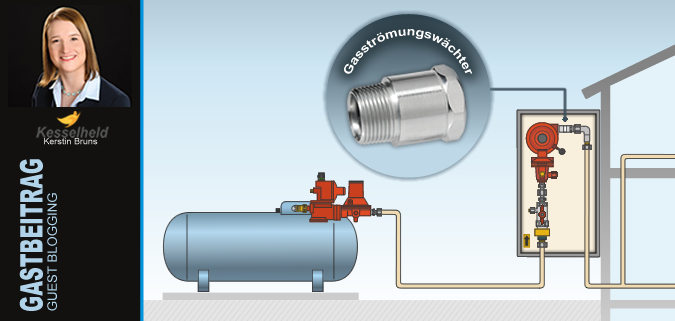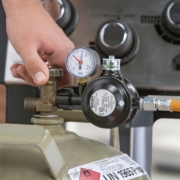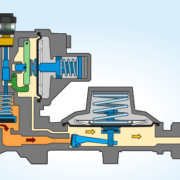How does an excess flow valve for LPG systems work?
The German LPG Association (DVFG) obliges the operator of an LPG system for private purposes in accordance with the technical rules for LPG (for short: TRF 2012) to incorporate an excess flow valve. Each new gas heating system must therefore have this safety component. If you make major changes to your LPG heating system, you must install an excess flow valve.
This blog post provides information on how to operate an excess flow valve (GS) and how it protects residents from dangerous gas leakage.
Design and installation
An excess flow valve is a safety component in the LPG system. There is a type of valve inside this component. This consists of a valve seat, a spring and a valve plate. Internal damping ensures fault-free operation of the LPG system when the output is changed.
Background and purpose of this component
A gas line must never be put into operation without prior inspection by the specialist. First, ensure that all pipes and fittings are in perfect condition. In addition, it must be checked whether there is any damage on the pipe or any leakage. The gas is only then inserted into the line.
You are currently viewing a placeholder content from Youtube. To access the actual content, click the button below. Please note that doing so will share data with third-party providers.
Despite intensive inspection, the gas line is not generally protected from leaks or manipulation in the long term.In the event of such defects, the excess flow valve will kick in and stop the LPG supply. The GS is a component that ensures manipulation security. It responds if the set flow rate is exceeded, for example by loosened compression fittings or disconnected piping, and it blocks the gas flow. As an overflow opening is required for the automatic opening, the gas shut-off valve must be closed as quickly as possible after the safety device responds.
A simple explanation of the function:
An excess flow valve responds to the LPG flowing through it. If, as described above, there is a defect in the LPG system or the gas line itself, the gas will flow through the GS more quickly. This results in a pressure drop in the gas line behind the excess flow valve. At the same time, gas flows into the supply line so that there are different pressures in the lines upstream and downstream of the installed excess flow valve. This uneven pressure ratio means that the valve plate sits in the valve seat of the valve. This process blocks the gas supply into the downstream piping.
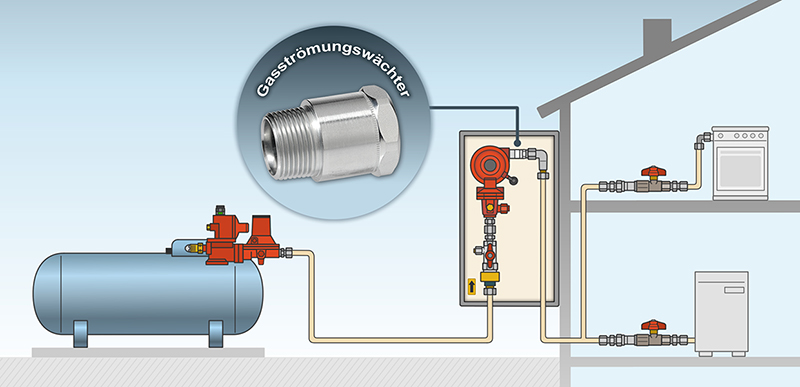
The example shows a typical tank system with an LPG tank. The excess flow valve is installed after the second stage of the pressure control.
Can an excess flow valve be used several times?
If the gas line is checked and tight again, gas flows from the supply line through the overflow opening of the excess flow valve into the gas line. This process means that gas pressure builds up in the lines downstream of the excess flow valve. If the pressure is equalised, the GS opens and is ready for use. Therefore, an excess flow valve can be used several times.
Caution:When restarting a gas line or a gas system, it is to be ensured that the gas is slowly let into the line as otherwise the excess flow valve closes the inside valve and the gas supply stops. In this case, the following lines are only filled through the overflow opening and this can take a longer period depending on the line length.
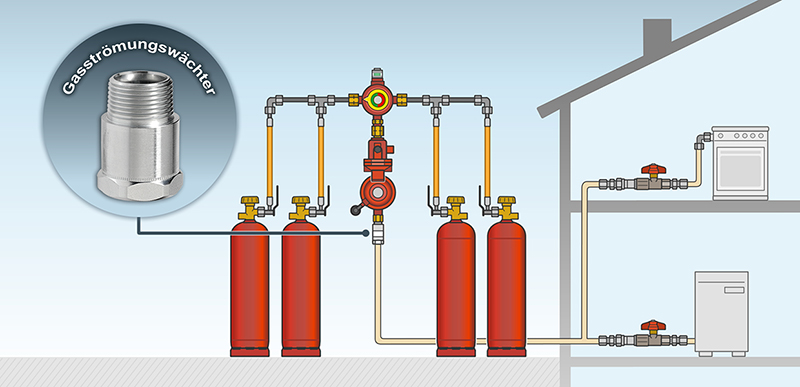
If the LPG cylinder system is set up according to the TRF and it uses 33-kilogram cylinders, the operator requires an excess flow valve.This is located between the pressure regulator and the supply line.
What should be taken into account in terms of design?
The following parameters must be taken into account when dimensioning your excess flow valve:
- The supply pressure. Because, depending on the pressure ratio, the site of installation of the excess flow valve changes.
- The sum of all connected loads
- The nominal values of the gas line
The heating fitter or your LPG supplier will be happy to help you select the right excess flow valve based on the appropriate values.
Here you can also find interesting information on what to consider when purchasing a gas heater.
Please observe our note that the work on the system described above may only be carried out by a qualified person.
